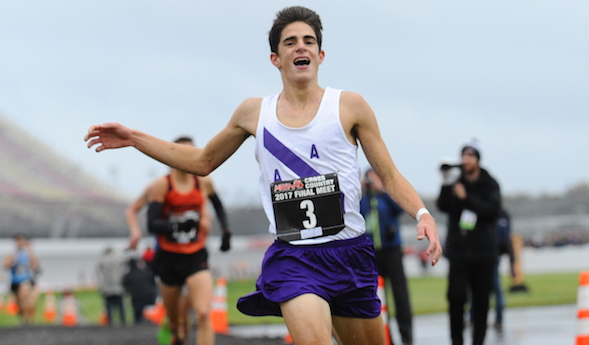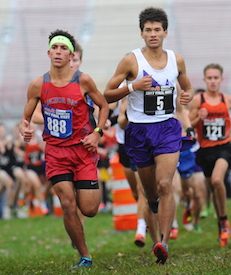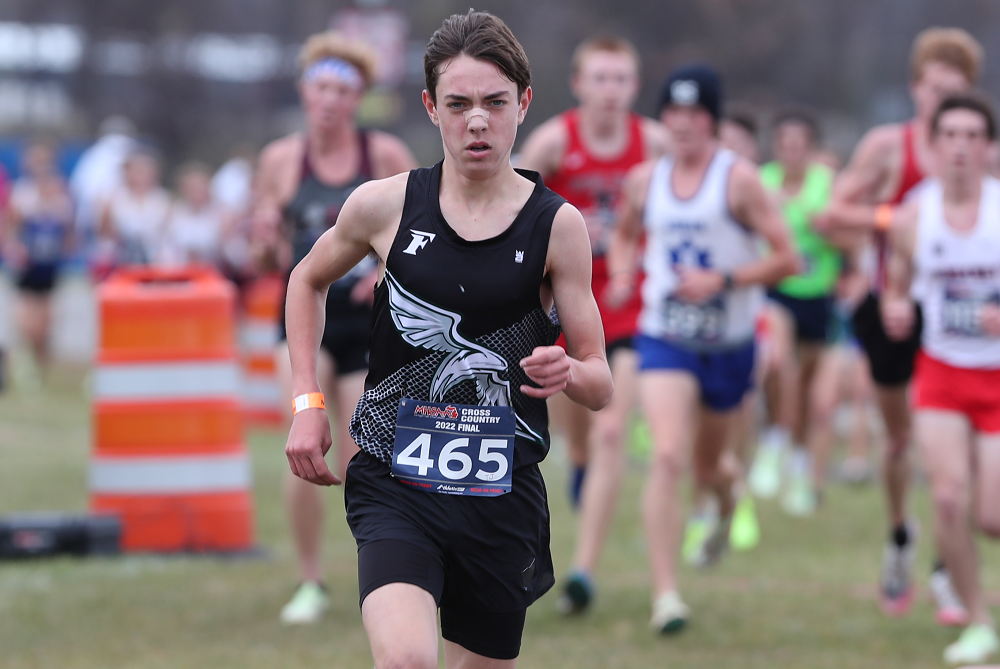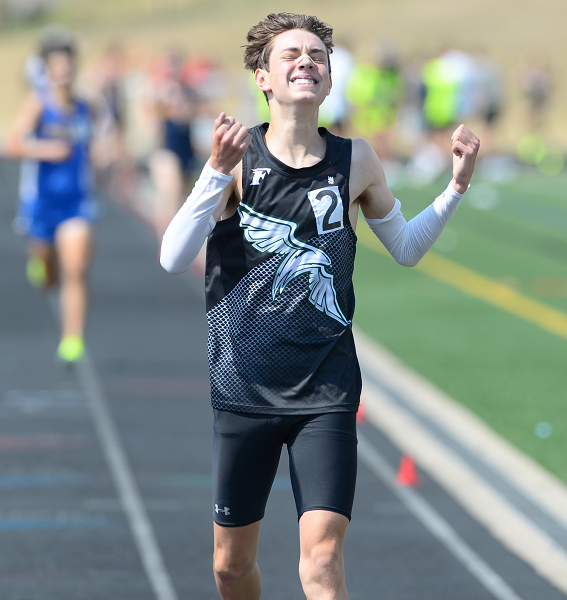
Pioneer Closes Finals with D1 Sweep
November 4, 2017
Second Half reports
BROOKLYN — On top of the normal pressure of racing in the MHSAA Cross Country Finals, runners in the boys Division 1 meet Saturday had to wait through two weather delays before taking the course at Michigan International Speedway.
Every team and every runner had different ways of coping with the extra dose of stress.
What did Ann Arbor Pioneer do?
Sing.
“We just act like it never happened,” Pioneer junior Nick Foster said. “Our team stayed loose and tried to act like it was a normal race, a normal start. We actually did start singing Bob Marley’s ‘Don’t Worry About a Thing’ to stay loose. It’s fun. We knew this was a good opportunity for our team. We wanted to execute.”
The Pioneers brushed aside the one-hour, 10-minute delay and swept the team and individual championships in Division 1.
Pioneer edged Plymouth by a slim 107-110 margin, while Foster unleashed a fierce kick to win a three-man battle for the individual title.
Rockford senior Cole Johnson was leading with the finish line in sight, but Foster stormed from behind to take the lead with about 20 yards remaining. Foster crossed the line in 15:16.1, Johnson was second in 15:18.2 and White Lake Lakeland junior Harrison Grzymkowski was third in 15:18.4.
“I realized it was coming down to the end,” Foster said. “I saw he was fading, so I tried to catch him. There was also someone right behind me. I just gave it everything I had at the end, just to see what happened. Cole’s such a good runner. I didn’t think it was possible.”
 It was the sixth team championship for Pioneer, which last won in 2008.
It was the sixth team championship for Pioneer, which last won in 2008.
“That’s more important to me than winning individually,” Foster said. “I just know if I get first, that’s the best I can do for the team. We have such a strong team this season with a lot of seniors. I wanted to do it for them.”
After Foster, the Pioneers’ next four runners finished within 16.8 seconds of each other. Senior Aldo Pando-Girard was 20th among team runners in 15:59.1, junior John Florence was 25th in 16:11.5, senior Jack Wallace was 26th in 16:12.0 and senior Philip Valtadoros was 35th in 16:15.9.
By coming in second, Plymouth had the best finish in school history, eclipsing third-place finishes in Class B in 1944 and 1947. The Wildcats hadn’t finished in the top 10 since taking 10th in Class A in 1961.
Led by sophomore Carter Solomon’s fifth-place overall finish in 15:24.2 and with only one senior in the top six, Plymouth might improve upon that showing next year.
Defending champion Lakeland took third with 130 points.
PHOTOS: (Top) Ann Arbor Pioneer’s Nick Foster crosses the finish line at Saturday’s Division 1 Final. (Middle) Pioneer’s Aldo Pando-Girard (5) and New Baltimore Anchor Bay’s Michael Zedan (888) race through a stretch. (Click for more from RunMichigan.com.)

Freeland's Hansen Not Focused on Joining All-Time Greats - But On His Way
By
Paul Costanzo
Special for MHSAA.com
September 29, 2023
The goal written on Matt Kaczor’s Post-It Note was sub-15 minutes, 15 seconds. That’s what the Freeland cross country coach was hoping for from star runner TJ Hansen during his junior season.
 Kaczor tore it up after seeing Hansen run a single race this fall.
Kaczor tore it up after seeing Hansen run a single race this fall.
“Knowing what he did over the summer and where he was at, seeing what his 1,600 (meter) and his mile got down to, I had a feeling he could get under 15:30 quickly,” Kaczor said. “After the first race, I looked at my assistant and was like, ‘I’ve gotta rip up that Post-It Note. I don’t think our goal is on the level of where he’s at right now.’ At first, it was break 15:15. Once I saw him race at the Under the Lights (on Aug. 18 at St. Johns), I was like, ‘Yeah, he’s going sub 15.’”
Hansen ran 15:39.6 in that first race, and on Sept. 7, in Shepherd, he ran 15:13.9 to meet the goal written on the now-shredded Post-It Note.
This past Saturday, he ran 15:03.7 at the Cadillac Veterans Serving Veterans Invitational. It’s the fastest time recorded in Michigan this year, and a signal that Kaczor might be filling out a new Post-It Note before the season is out.
“The sub-15 barrier, that’s been something on my mind for a while,” Hansen said. “Now that I’m edging closer and closer to that, it’s been exciting. With how heavy my training has been, I wouldn’t expect (to have run this fast this early). Being able to run the times I am really paints the picture for what’s ahead.”
Hansen came into the season already regarded as one of the elite distance runners in the state. He won the 3,200 meters at the MHSAA Lower Peninsula Division 2 Track & Field Finals this past spring. He’s also finished all-state (12th and fifth, respectively) the past two seasons at the LPD2 Cross Country Finals.
His current trajectory, however, would put his name near some of the state’s all-time greats. But that’s not something Hansen is focusing on.
“I really don’t like to compare myself to others,” he said. “I don’t focus on that. I try to be the best TJ Hansen that I can be. The best version of myself.”
Focusing on himself is almost necessary for Hansen, as he’s spending a lot of time during his races running by himself.
At each of the big events Freeland has run in this season, Hansen has finished at least 20 seconds ahead of his nearest competitor. That includes all divisions of the Duane Raffin Festival of Races in Holly.
In Cadillac, where Hansen ran his current best time, he was a full minute ahead of the rest of the field.
 “He’s just a special athlete,” Kaczor said. “I can’t see Freeland having someone like this in a while. He’s a generational talent. What’s crazy is, I had the school record when he was a freshman. He and Braden (Honsinger) broke it last year. But TJ has now dropped that school record (set in 1998) by almost a minute.”
“He’s just a special athlete,” Kaczor said. “I can’t see Freeland having someone like this in a while. He’s a generational talent. What’s crazy is, I had the school record when he was a freshman. He and Braden (Honsinger) broke it last year. But TJ has now dropped that school record (set in 1998) by almost a minute.”
Hansen’s achievements have already put him on a path to run at the next level, which is something of a family tradition.
His older sisters Peyton and Kiera are track & field athletes at Wayne State and Eastern Michigan, respectively. Their parents, Tim and Pam, were track & field stars at Central Michigan.
TJ has drawn the attention of coaches around the country, including from Michigan, Michigan State, Wisconsin, Tennessee and Colorado.
Having family members who know the process is a help for Hansen, and he said they’ve all been good about allowing him to choose his own path, whatever that may be.
“He’s from a good family that knows how to work and knows how to get things done,” Kaczor said. “He knows that if he puts in the work, he’s going to be at a good spot.”
While Hansen admits it can be a bit overwhelming, he’s using it as motivation to run faster and continue to put his name out there.
Also serving as motivation is 2022 Division 2 champion Connell Alford of Chelsea. Alford is among the elite group of runners in Michigan who have broken the 15-minute mark, doing it twice a year ago.
He currently has the state’s second-best time behind Hansen’s this year, running 15:09.1 at the MSU Invitational on Sept. 15.
“Whenever I see him drop a time, my main goal is to run faster,” Hansen said. “Whenever I see him run a good time, that motivates me to work hard.”
The two won’t see each other until the MHSAA Finals on Nov. 4 at Michigan International Speedway. It’s an opportunity Hansen is excited for, as it’s a chance to race and be pushed toward the lofty goals he’s set for himself. Kaczor is excited about it, too, even if it might mean having to replenish his supply of Post-Its.
“We don’t talk about winning the state title; we talk about making sure that we have great races on those days,” Kaczor said. “We can’t control how somebody else runs. It’s a matter of can we, if the weather is right and the course is in good condition, can we be one of the few guys that has run in the 14s on that course? That’s the goal. Put yourself in some great categories with those upper echelons and the greats of all-time.”
 Paul Costanzo served as a sportswriter at The Port Huron Times Herald from 2006-15, including three years as lead sportswriter, and prior to that as sports editor at the Hillsdale Daily News from 2005-06. He can be reached at [email protected] with story ideas for Genesee, Lapeer, St. Clair, Sanilac, Huron, Tuscola, Saginaw, Bay, Arenac, Midland and Gladwin counties.
Paul Costanzo served as a sportswriter at The Port Huron Times Herald from 2006-15, including three years as lead sportswriter, and prior to that as sports editor at the Hillsdale Daily News from 2005-06. He can be reached at [email protected] with story ideas for Genesee, Lapeer, St. Clair, Sanilac, Huron, Tuscola, Saginaw, Bay, Arenac, Midland and Gladwin counties.
PHOTOS (Top) Freeland's TJ Hansen leads a pack during last season's LPD2 Final at Michigan International Speedway. (Middle) Hansen enjoys a moment of exhilaration after winning the 3,200 this spring at the LPD2 Finals at Ada Forest Hills Eastern. (Top photo by Carter Sherline/Run Michigan; middle photo by Dave McCauley/Run Michigan.)

